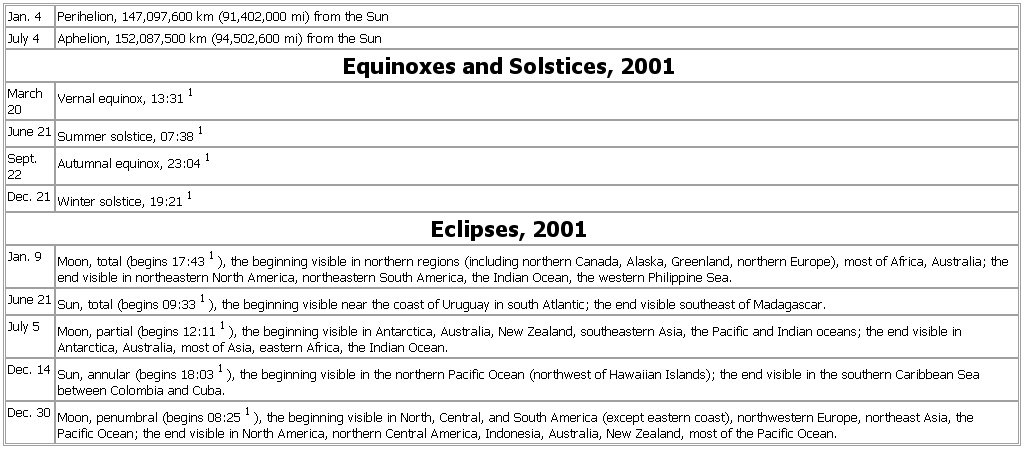- Earth Perihelion and Aphelion, 2001
-
▪ 2001Earth Perihelion and Aphelion, 2001Jan. 4 Perihelion, 147,097,600 km (91,402,000 mi) from the SunJuly 4 Aphelion, 152,087,500 km (94,502,600 mi) from the SunEquinoxes and Solstices, 2001March 20 Vernal equinox, 13:311June 21 Summer solstice, 07:381Sept. 22 Autumnal equinox, 23:041Dec. 21 Winter solstice, 19:211Eclipses, 2001Jan. 9 Moon, total (begins 17:431), the beginning visible in northern regions (including northern Canada, Alaska, Greenland, northern Europe), most of Africa, Australia; the end visible in northeastern North America, northeastern South America, the Indian Ocean, the western Philippine Sea.June 21 Sun, total (begins 09:331), the beginning visible near the coast of Uruguay in south Atlantic; the end visible southeast of Madagascar.July 5 Moon, partial (begins 12:111), the beginning visible in Antarctica, Australia, New Zealand, southeastern Asia, the Pacific and Indian oceans; the end visible in Antarctica, Australia, most of Asia, eastern Africa, the Indian Ocean.Dec. 14 Sun, annular (begins 18:031), the beginning visible in the northern Pacific Ocean (northwest of Hawaiian Islands); the end visible in the southern Caribbean Sea between Colombia and Cuba.Dec. 30 Moon, penumbral (begins 08:251), the beginning visible in North, Central, and South America (except eastern coast), northwestern Europe, northeast Asia, the Pacific Ocean; the end visible in North America, northern Central America, Indonesia, Australia, New Zealand, most of the Pacific Ocean.See as table:
 1Universal time.Source: The Astronomical Almanac for the Year 2001 (2000).
1Universal time.Source: The Astronomical Almanac for the Year 2001 (2000).* * *
Universalium. 2010.
